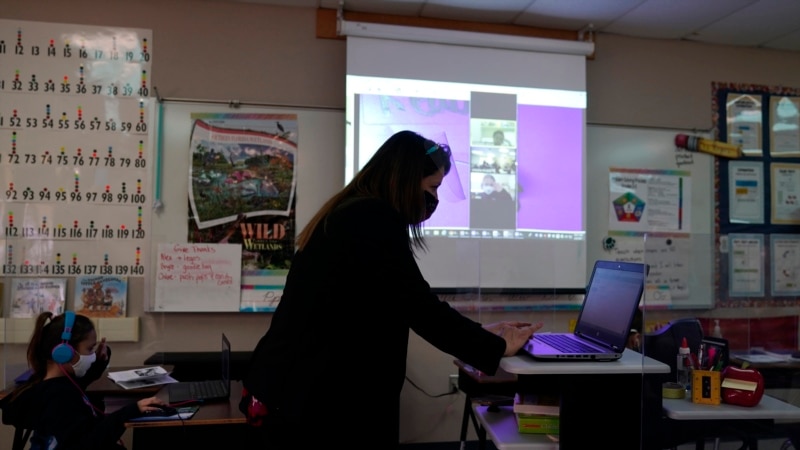
In Teaching Online, Educators Learn as They Go
School districts around the United States were not ready for online learning when the coronavirus health crisis hit – and it affected students.
Research on test scores over the past year suggests that students’ learning slowed down. A study by the Center for Reinventing Public Education (CRPE) pointed to school closures and the switch to remote learning as likely reasons for the problem.
Lawmakers and parents have said the return to in-person classes is important for this school year. But education experts say online classes are here to stay and that students need to know how to learn online to be prepared for college and the workforce.
Christine Pitts is an education expert with CRPE. She said that it is hard to judge the effectiveness of last year’s remote learning. Many school districts had to make a quick change to remote classes during the health crisis and were not prepared.
“We know that virtual learning is not going to go away in a post-COVID world,” Pitts said. “But we also know that it cannot be the same as emergency learning.”
Pitts said there is little research on how to structure online classes. She said few education researchers have looked at online teaching methods at the kindergarten through 12th grade level.
“Not having that evidence makes it really hard for systems leaders, for teachers, for superintendents to make those decisions about how to design remote learning moving forward,” Pitts said.
Educators do have some research about how to structure online learning.
For example, research suggests that children learn better when they can physically move around. Online classes could support this kind of behavior by asking students to take walks or do activities away from the computer, argued Katie Taylor in the publication The Conversation. She is a professor of learning sciences and human development at the University of Washington.
Learning the best methods for online teaching has taken some time, said Judy Perez. She is an educator with 20 years of experience in online education at the kindergarten through 12th grade level. She is also the head of iLearn Collaborative in Colorado. It is a non-profit organization that trains teachers in online teaching methods.
Colorado passed a law in 2007 that expanded online and hybrid classes in the state. Hybrid classes mix online and in-person instruction.
Perez began teaching virtual instruction in 2001 when “we didn’t know what we were doing. We were just trying to figure out, how do we teach in this space?”
But over time, she and other experts were able to develop training methods and measure student performance in online classrooms.
Last year, Perez said many teachers in the districts she worked with before the pandemic were surprised. They found they were able to make the change from in-person to virtual learning quickly when the pandemic started. She said, however, that student learning was affected by how well-trained a teacher was in online instruction.
“I think you would see a difference in student…learning depending on how well-trained the teachers were and those that just jumped into this environment,” Perez said.
Taking a lesson meant for the classroom and simply moving it online does not work, she said. Teachers need to be able to use the online environment and computer technology to keep their students interested. They also need to build relationships with their students, said Jill Pelligrini. She also trains teachers for iLearn Collaborative.
“What we’ve been doing with our training is really focusing on that student engagement,” Pellegrini said. “How do you build community? How do you build relationships?”
Pitts said that kids learning at home have made parents more involved in their child’s schooling. It has become easier for parents to see what their children are learning and how they are progressing. They can ask teachers questions about what is being learned.
It is something “that we want to pull forward into whatever remote learning occurs” in the future, Pitts said.
Perez said that all students should have some experience with online learning. Those that do not will have a harder time when they go to college or enter workforce-training programs that use online instruction, she said.
Perez added she does not recommend fully online schooling. But she said hybrid classes could be better for students needing special consideration like athletes and those with disabilities or health problems.
Pitts noted that there is little research about how to teach virtual classes, what classes are easier or harder to teach online, or what kinds of students are best for it.
“It’s such an understudied type of teaching,” she said.
I’m Dan Novak.
Dan Novak wrote this for VOA Learning English. Mario Ritter, Jr. was the editor.
Words in This Story
district –n. an area established by a government for official government business
remote — adj. done from a distance; away from a place
superintendent –n. a person who directs or manages a place, department, organization
figure out –v.(phrasal) to understand or find something by thinking
optimal — adj. the best; the most effective way
focus –v. to place attention on something
virtual — adj. existing or occurring on computers or on the Internet
engagement — n. the act or state of being involved with something
occur –v. to take place; to happen
type –n. a kind of something
Share this article:
This article uses material from the VOA Learning English article, and is in public domain. Images and videos are available under their respective licenses.
